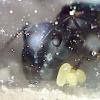At least I'm assuming they're infertile as I got them as they were swarming around the nest before they flew. I put all four of the Dorymyrmex bicolor in one container. Just wait and see? Throw them into the yard? Throw them in the freezer?
I also notice they're very active and try to escape upwards as opposed to the D. insanus queens I dug up from founding chambers who try to hide and escape downwards. My insect intuition is fertile queens would want to do the latter.


















